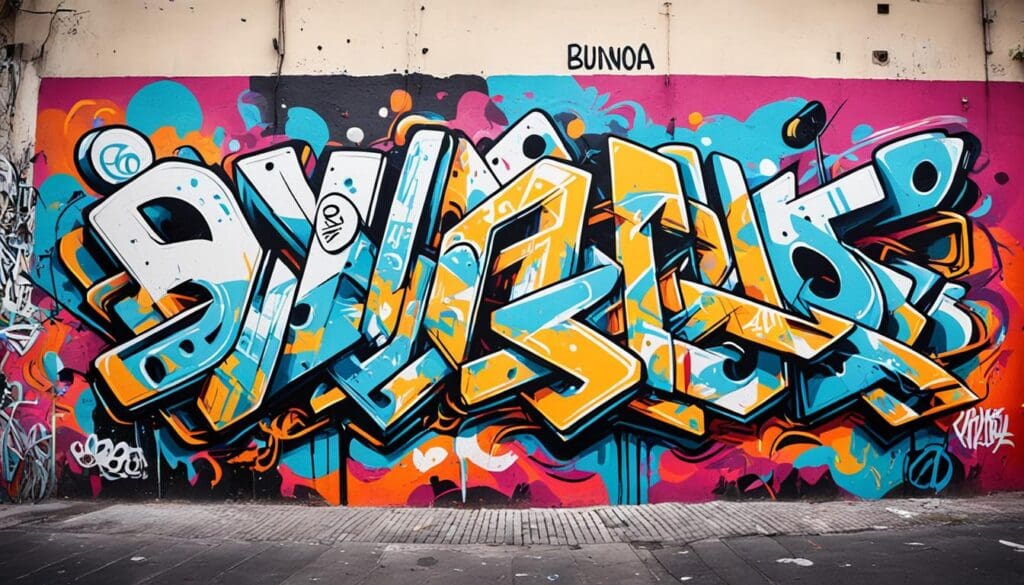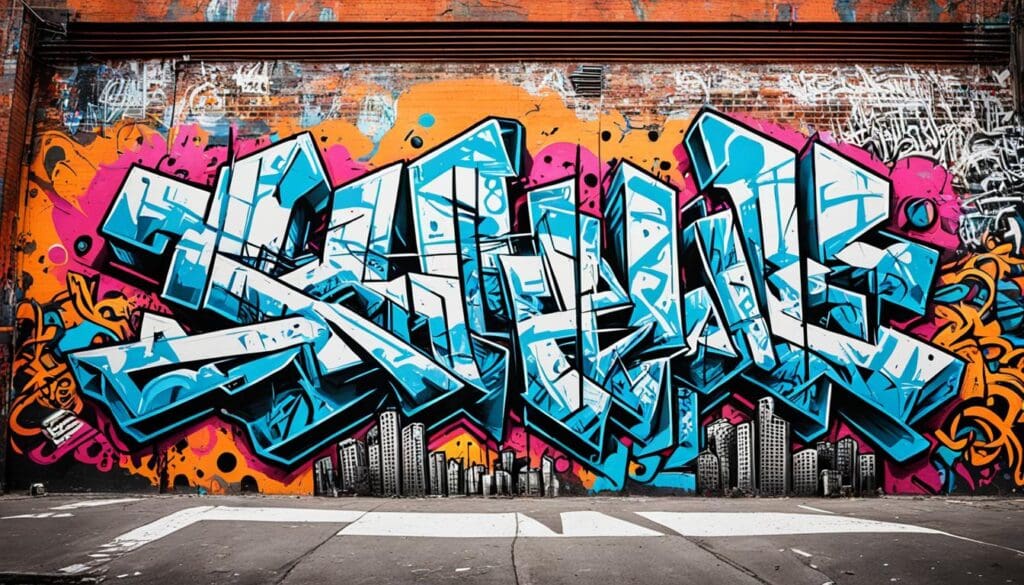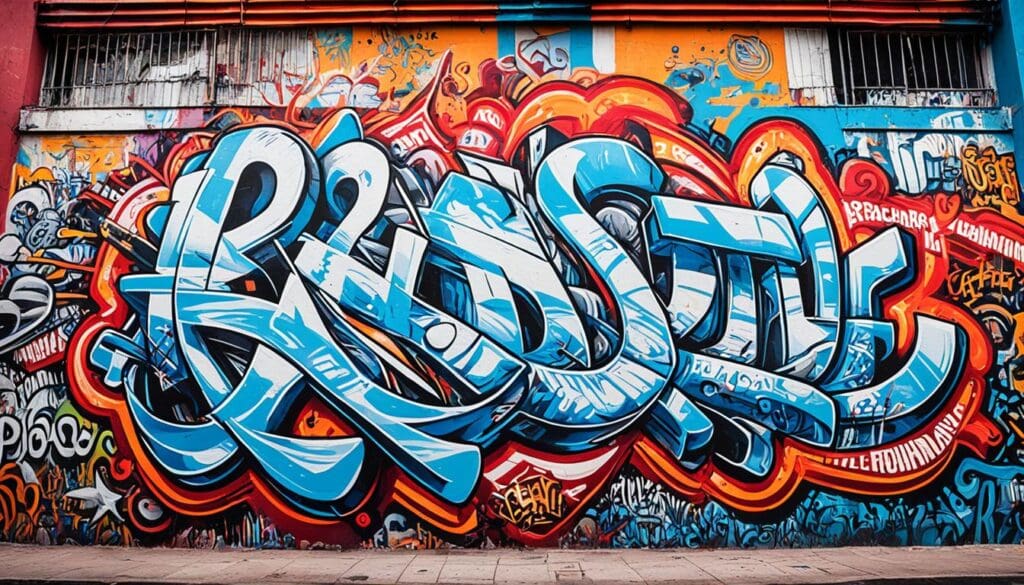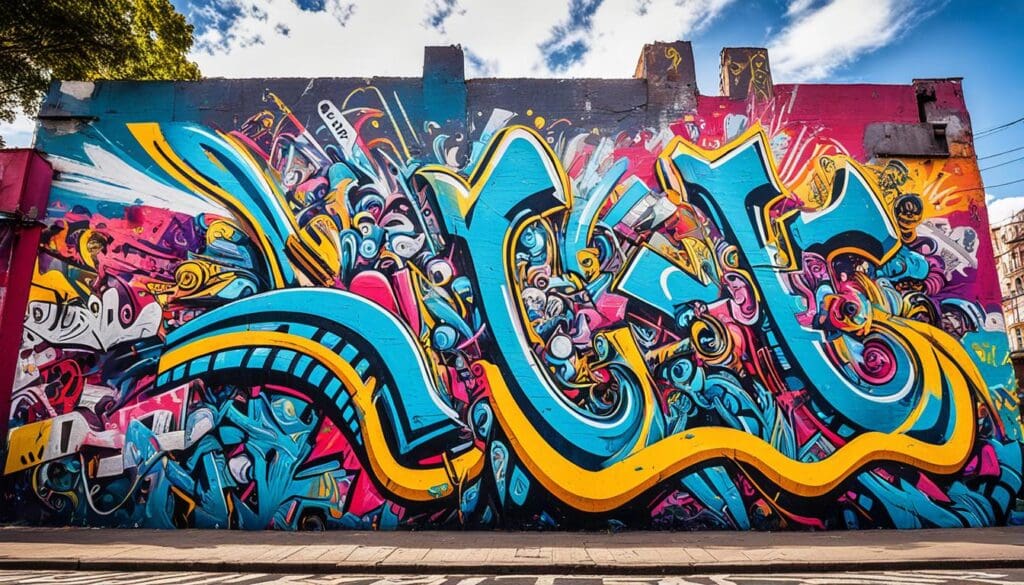Graffiti in Buenos Aires is more than just art on the walls; it is a vibrant language that reveals the heart of Argentine street culture. The city is renowned for its rich graffiti scene, with talented muralists and graffiti artists creating stunning works of urban art. The graffiti culture in Buenos Aires is deeply rooted in South American graffiti traditions, and it has become an integral part of the city’s identity. From the colorful tags that adorn the city’s walls to the intricate murals that tell stories, Buenos Aires’ graffiti language is a fascinating subject to explore.
Have you ever wondered what stories these graffiti tags and murals in Buenos Aires tell? What secrets does the language of the streets hold?
Aprender Español es Facil!
In this article, we will delve into the language of Buenos Aires’ street art, decoding the graffiti tags and unraveling the narratives behind the murals. Join us on this journey through the vibrant streets of Buenos Aires and discover the cultural significance of this unique form of expression.
The Evolution of Graffiti in Buenos Aires
Graffiti in Buenos Aires has undergone a remarkable evolution, transforming from an act of vandalism to a revered form of artistic expression. The city’s graffiti scene has experienced a metamorphosis, attracting talented muralists and graffiti artists who continuously push the boundaries of creativity. This evolution of the Buenos Aires graffiti language is a testament to the vibrant graffiti culture that thrives in South America.
The streets of Buenos Aires bear witness to the growth and development of the graffiti language, showcasing the diverse influences that shape Latin American street art. From the colorful tags that cover walls to the intricate murals that adorn buildings, Buenos Aires has become a canvas for artists to express their unique perspectives and talents.
The Rise of Buenos Aires Muralists
Buenos Aires is home to a thriving community of muralists who have played a key role in the evolution of the city’s graffiti language. These talented artists have elevated street art to new heights, transforming entire facades into captivating works of art. Their murals reflect the rich cultural heritage of Argentina and often serve as a medium for social commentary and storytelling.
Latin American street art has had a profound influence on the Buenos Aires graffiti scene, with muralists integrating elements of Argentine artistic traditions into their work. The vibrant colors, intricate details, and bold imagery found in Buenos Aires murals are a testament to the unique fusion of Latin American and Argentine mural art.
The Dynamic Nature of Buenos Aires Street Art
Buenos Aires’ graffiti language is constantly evolving, adapting to the changing dynamics of the city and the ever-evolving graffiti culture. The artists draw inspiration from a myriad of sources, including global street art movements and the unique experiences of living in Buenos Aires.
- The vibrant and expressive graffiti found in Buenos Aires showcases the innovative techniques and styles employed by local artists.
- The graffiti culture in Buenos Aires serves as a platform for artists to voice their thoughts, emotions, and experiences, capturing the essence of Argentine street culture.
- Buenos Aires graffiti is an integral part of the city’s urban landscape, contributing to its identity and attracting visitors from around the world.
The evolution of graffiti in Buenos Aires is a testament to the transformative power of street art and its ability to shape and redefine urban spaces. The dynamic nature of the Buenos Aires graffiti language ensures that it continues to captivate and inspire both residents and visitors alike.
Decoding Graffiti Tags: Symbols and Styles
Graffiti tags are an essential part of the Buenos Aires graffiti language. They are the unique signatures left by graffiti artists and serve as their personal identifier. Decoding graffiti tags involves understanding the symbols and styles used by each artist. In Buenos Aires, various symbols and styles are used, ranging from elaborate lettering to simplified designs. These tags often convey the artist’s message or mark their territory in the city. By deciphering these symbols and styles, one can gain insight into the individual artists and their contributions to the Buenos Aires graffiti scene.
To better understand the diverse symbols and styles used in Buenos Aires graffiti, we can explore some common elements:
Symbolism in Graffiti Tags
Many graffiti artists in Buenos Aires incorporate symbols into their tags to convey deeper meanings. These symbols can represent personal beliefs, cultural references, or even social and political commentary. For example, a clenched fist might symbolize strength or activism, while a crown might indicate a sense of power or royalty. These symbols add layers of interpretation to the graffiti tags and invite viewers to engage with the artist’s message.
Styles of Graffiti Tags
The styles of graffiti tags in Buenos Aires vary widely, reflecting the unique artistic expressions of each artist. Some artists focus on elaborate lettering, using intricate calligraphy or decorative fonts to create visually striking tags. Others prefer a more simplified approach, using bold, block letters to make a bold statement. Additionally, some artists incorporate elements from other art forms, such as comic book illustrations or abstract designs, into their tags. These different styles contribute to the diversity and vibrancy of the Buenos Aires graffiti scene.
Decoding graffiti tags requires an appreciation for the visual language created by graffiti artists in Buenos Aires. By understanding the symbols and styles used, we can delve deeper into the narratives and perspectives of these talented artists. Let’s take a closer look at some examples:
| Artist | Tag | Symbol/Style |
|---|---|---|
| Lucia |   | Simplified block letters with a star symbol |
| Pablo | Elaborate calligraphy with a bird symbol | |
| Valentina |   | Abstract design with vibrant colors |
These examples showcase the diversity of symbols and styles used by graffiti artists in Buenos Aires. Each artist’s tag tells a unique story and adds to the rich tapestry of the Buenos Aires graffiti scene.
Storytelling Through Murals: Themes and Imagery
Murals are an integral part of the dynamic Buenos Aires graffiti language and serve as large-scale canvases for artists to express their ideas, evoke emotions, and convey powerful messages to the public. Through these captivating artworks, muralists contribute to the visual storytelling of the city, creating a vibrant dialogue with both locals and visitors.
The themes and imagery found in Buenos Aires murals are diverse, reflecting the multifaceted nature of Argentine society. These striking artworks cover a wide range of subjects, including:
- Social Issues: Murals in Buenos Aires often tackle pressing social issues, such as inequality, poverty, and human rights. Artists use their creations to shed light on these important topics, stimulating conversations and inspiring action.
- Political Commentary: The city’s murals are also powerful platforms for political expression and commentary. Artists use their brushstrokes to critique government policies, advocate for change, and represent the diverse political perspectives of the Argentine people.
- Cultural Heritage: Buenos Aires murals pay homage to the rich cultural heritage of Argentina. These artworks celebrate the country’s indigenous roots, iconic figures, traditional folklore, and historical events, preserving and sharing Argentine culture with both locals and global audiences.
- Personal Narratives: Many murals in Buenos Aires carry personal narratives, offering glimpses into the lives and experiences of the artists themselves. Through these intimate stories, muralists create a sense of connection and empathy, bridging the gap between artist and viewer.
The imagery used in Buenos Aires murals is often vibrant, bold, and thought-provoking. Artists employ a variety of artistic styles, including realism, surrealism, and abstract forms, to convey their messages effectively. These visually striking murals, with their intricate details and captivating colors, transform the city’s walls into open-air galleries.
The impact of these murals goes beyond aesthetics, bringing communities together and fostering a sense of pride and ownership. They serve as visual landmarks, defining neighborhoods and contributing to the unique character of Buenos Aires. Street art enthusiasts and visitors from around the world are drawn to the city to immerse themselves in the vibrant Buenos Aires graffiti scene.
Whether it’s a thought-provoking social critique or a heartfelt depiction of Argentine culture, the themes and imagery found in Buenos Aires murals reflect the city’s cultural richness, inviting viewers to engage with the stories and emotions conveyed by these captivating artworks.
| Key Themes | Imagery |
|---|---|
| Social Issues | Bold, striking imagery that confronts societal challenges head-on |
| Political Commentary | Powerful symbols and references that critique government policies and advocate for change |
| Cultural Heritage | Vibrant representations of indigenous culture, traditional folklore, and historical events |
| Personal Narratives | Intimate and emotive depictions that share artists’ personal stories and experiences |
Influences and Inspirations in Buenos Aires Graffiti
The Buenos Aires graffiti language is a product of diverse influences and inspirations that shape the city’s vibrant urban art scene. Graffiti artists in Buenos Aires draw inspiration from a range of sources, blending local culture, global street art movements, and their own artistic visions. This fusion of influences and inspirations results in a unique and dynamic graffiti language that reflects the identity of Buenos Aires.
One significant influence on Buenos Aires graffiti is the rich local culture. Argentine street artists often incorporate elements of Argentine history, indigenous culture, and everyday life into their work. These artistic expressions serve as a reflection of the city’s heritage and create a sense of connection between the graffiti and the local community.
International street art scenes also play a role in shaping Buenos Aires graffiti. Artists look to global movements in Europe and the United States for inspiration and artistic techniques. They incorporate these influences into their work, bringing a fresh perspective to the Buenos Aires graffiti scene.
Indigenous Cultural Influences
Buenos Aires graffiti artists are deeply inspired by the indigenous cultures of Argentina. Incorporating indigenous symbols, patterns, and imagery into their work, they pay homage to the country’s diverse indigenous heritage. These cultural influences add depth and meaning to Buenos Aires graffiti, fostering a connection with the past and celebrating indigenous traditions.
Social and Political Commentary
Argentina’s political landscape and social issues are also strong influences on Buenos Aires graffiti. Artists use their work to express their opinions, challenge societal norms, and spark conversations. Graffiti murals in Buenos Aires often address topics such as inequality, human rights, and political activism. Through their art, graffiti artists contribute to the ongoing dialogue surrounding these issues in Argentine society.
International Street Art Movements
Buenos Aires’ graffiti scene is not limited to local influences; it thrives on its connection to global street art movements. International street art festivals, exhibitions, and collaborations provide opportunities for artists from different countries to exchange ideas and showcase their work. These interactions contribute to the cross-pollination of styles, techniques, and inspirations within the Buenos Aires graffiti scene.
Through a blend of local culture, global influences, and personal inspirations, Buenos Aires graffiti artists create a dynamic and ever-evolving graffiti language. The city’s urban art scene continues to flourish as artists push boundaries, experiment with new techniques, and inspire the next generation of graffiti artists.
| Artistic Influences | Examples |
|---|---|
| Indigenous Culture | Incorporating indigenous symbols and patterns into graffiti murals |
| Social and Political Commentary | Addressing issues of inequality and human rights through graffiti |
| International Street Art Movements | Exchanging ideas and techniques with artists from around the world |
The Impact of Buenos Aires Graffiti on Urban Spaces
Buenos Aires graffiti language, street art Buenos Aires, urban art Argentina, Buenos Aires graffiti scene
Buenos Aires graffiti has a profound impact on the urban spaces it occupies. It breathes life into mundane walls and buildings, transforming them into vibrant and visually captivating environments. The city’s graffiti language has the remarkable ability to spark conversations, challenge societal norms, and beautify neglected areas. Through the creativity of local artists, Buenos Aires’ graffiti scene has brought color and inspiration to countless neighborhoods.
Street art tours and festivals have emerged as a way to showcase the city’s dynamic graffiti scene. These events offer visitors and locals alike the opportunity to explore and appreciate the diverse works of art that adorn Buenos Aires’ urban landscape. They serve as platforms for artists to create legally sanctioned murals and share their talents with a broader audience.
The impact of Buenos Aires’ graffiti on urban spaces is undeniable. It contributes to the revitalization of neglected areas, transforming them into thriving cultural hubs. The graffiti language not only adds aesthetic value but also encourages dialogue and reflection, challenging passersby to consider the meaning behind the art.
- By injecting color and creativity into the city’s streets, graffiti artists have turned once-forgotten corners into must-see destinations for street art enthusiasts from around the world.
- The visual impact of Buenos Aires’ graffiti sends a powerful message of cultural expression and artistic freedom.
- The city’s graffiti scene has become an integral part of the urban fabric, enriching the lives of residents and visitors alike.
The impact of Buenos Aires’ graffiti on urban spaces is a testament to the power of art to transform and inspire change. It is a reflection of the city’s vibrant street culture and the immense talent of the graffiti artists who call Buenos Aires home.
The Role of Graffiti Artists in Buenos Aires
Graffiti artists play a crucial role in shaping and maintaining the Buenos Aires graffiti language. They are the creative minds behind the vibrant tags and murals that adorn the city’s walls. Graffiti artists in Buenos Aires come from diverse backgrounds and bring their unique perspectives to the art form. They often face challenges, including legal issues and the constant threat of their work being removed or painted over. However, they are determined to leave their mark on the city and continue to express themselves through their art.
These artists are the heart and soul of the Buenos Aires graffiti scene, infusing urban spaces with their creative energy and making a lasting impact on the city’s visual landscape. They capture the essence of the Buenos Aires graffiti language and translate it into stunning displays of art that reflect their individual styles and influences.
While graffiti artists may work in the shadows, their artwork speaks volumes, grabbing the attention of passersby and sparking conversations. Through their work, they challenge societal norms, address political and social issues, and showcase the culture and diversity of Buenos Aires.


Influential Graffiti Artists in Buenos Aires
| Artist Name | Signature Style | Influences |
|---|---|---|
| Fintan Magee | Realistic Portraits | Figurative Art, Social Issues |
| Blu | Muralistic Animations | Political Activism, Contemporary Art |
| Marta Minujín | Interactive Installations | Performance Art, Pop Art |
| Nazza Stencil | Stencil Art | Pop Culture, Graffiti Culture |
| Ever | Surreal Imagery | Latin American Indigenous Art, Nature |
These artists, among many others, have contributed to the vibrant and dynamic Buenos Aires graffiti scene, leaving their mark on the city and inspiring future generations of graffiti artists. Their work not only beautifies urban spaces but also serves as a reflection of the city’s identity and cultural heritage.
The Future of Buenos Aires Graffiti
The Buenos Aires graffiti scene is poised for a promising future, as the city continues to embrace street art and recognize its cultural value. With an increasing number of opportunities for graffiti artists to showcase their work and collaborate with local communities, the Buenos Aires graffiti language is set to soar to new heights.
Public support for graffiti art in Buenos Aires is on the rise, and there are various initiatives and projects aimed at preserving and celebrating the city’s urban art scene. These efforts not only provide platforms for artists to express themselves but also foster a sense of pride and appreciation for the graffiti language among the general public.
“Graffiti artists in Buenos Aires are no longer seen as vandals but as talented creatives who contribute to the vibrancy and identity of our city,” says Juan Martinez, a local street art enthusiast. “Their work adds color and life to otherwise dull spaces, creating an immersive experience for both locals and visitors.”
As the city evolves, so does the Buenos Aires graffiti language. Artists are constantly innovating and pushing the boundaries of their craft, experimenting with new styles, techniques, and materials. This ongoing evolution reflects the changing dynamics of the city and its street culture.
To celebrate the future of Buenos Aires graffiti, the city hosts annual street art festivals that attract both local and international artists. These festivals provide a platform for collaboration and exchange of ideas, further fueling the growth of the Buenos Aires graffiti scene.
“The future of Buenos Aires graffiti is bright, as it continues to captivate audiences and leave a lasting impact on the city’s urban spaces,” remarks Sofia Rodriguez, a curator at the Buenos Aires Urban Art Museum. “We are excited to see how the graffiti language will evolve, reflecting the diversity and creativity of our city.”
| Advancements | Implications |
|---|---|
| Increased recognition of graffiti as a form of art | Greater opportunities for artists to showcase their work and gain exposure |
| Collaboration between graffiti artists and local communities | Engagement with diverse voices and perspectives, fostering a sense of unity |
| Preservation and celebration of Buenos Aires’ urban art scene | Cultural enrichment and increased tourism attraction |
| Continual innovation and evolution of the Buenos Aires graffiti language | Dynamic and engaging urban spaces that reflect the city’s identity |
Exploring Buenos Aires’ Graffiti Culture
To fully appreciate the Buenos Aires graffiti language, one must immerse themselves in the city’s vibrant graffiti culture. Exploring Buenos Aires’ graffiti scene involves visiting neighborhoods known for their street art, such as Palermo, Villa Crespo, and La Boca, where walls and buildings become canvases for artistic expression.
One way to delve deeper into the graffiti culture is by taking a guided street art tour. These tours provide valuable insights into the history and significance of the graffiti in Buenos Aires. Local guides, who are often artists themselves, offer fascinating narratives and anecdotes that bring the graffiti to life. Interacting with these passionate individuals allows visitors to gain a deeper understanding of the Buenos Aires graffiti scene and its cultural impact.
Another exciting way to immerse oneself in the Buenos Aires graffiti culture is by attending street art festivals and exhibitions. These events showcase the latest works by talented graffiti artists, providing an opportunity to witness the evolution and innovation of the Buenos Aires graffiti language. From large-scale murals to intricate tags, these festivals capture the vibrancy and diversity of urban art in Argentina’s capital.
One must-see event is the Buenos Aires International Street Art Festival, which attracts renowned artists from around the world. The festival celebrates the transformative power of street art, allowing visitors to witness live mural painting, interactive installations, and engaging workshops. It is an immersive experience that offers a glimpse into the dynamic Buenos Aires graffiti scene.
Exploring Buenos Aires’ graffiti culture not only involves observing the artwork but also engaging with the community. Many graffiti artists are open to conversations and collaborations, and attending workshops or artist talks provides an opportunity to connect with these creative individuals. The collaborative nature of the graffiti culture fosters a sense of community and artistic exchange.
Top Neighborhoods for Graffiti Exploration:
| Neighborhood | Description |
|---|---|
| Palermo | Palermo is known for its colorful and diverse street art, featuring both large-scale murals and intricate tags. It showcases the creativity and innovation of Buenos Aires’ graffiti scene. |
| Villa Crespo | Villa Crespo is a hub for urban art, with its streets adorned with striking graffiti pieces. It offers a mix of established and emerging artists, representing the dynamic nature of the Buenos Aires graffiti language. |
| La Boca | La Boca is famous for its vibrant art scene, with its colorful buildings and iconic Caminito street. The neighborhood’s graffiti reflects the cultural heritage and spirit of Buenos Aires. |
By exploring Buenos Aires’ graffiti culture, visitors can gain a deeper understanding of the city’s identity and the expressive language of its street art. From the intricate symbolisms of graffiti tags to the grand narratives of murals, the Buenos Aires graffiti scene captivates and inspires, inviting all to embrace the creativity and cultural significance of urban art in Argentina.
The Cultural Significance of Buenos Aires Graffiti
The Buenos Aires graffiti language holds significant cultural significance for the city and its people. As a form of self-expression, graffiti allows individuals to convey their emotions and personal stories on the walls of Buenos Aires. The diverse voices and perspectives reflected in the graffiti tags and murals create a rich tapestry of urban art that resonates with the local community.
Beyond self-expression, graffiti in Buenos Aires also serves as a powerful tool for social commentary. Artists use their work to address social and political issues, highlighting injustices and advocating for change. From thought-provoking murals depicting human rights struggles to impactful tags demanding equality, Buenos Aires’ graffiti culture gives voice to the concerns and aspirations of its residents.
In addition to serving as a platform for self-expression and social commentary, Buenos Aires graffiti plays a crucial role in cultural preservation. The city’s urban art scene reflects Argentina’s rich cultural heritage, with indigenous symbolism and historical references often incorporated into the artwork. By visually preserving these cultural elements, graffiti artists contribute to the collective memory and identity of Buenos Aires, making it an integral part of the city’s fabric.
The Buenos Aires graffiti scene is not just about artistic value – it is an embodiment of the city’s spirit and a reflection of its people. The cultural significance of the Buenos Aires graffiti language, deeply rooted in the graffiti culture of South America, further solidifies the city’s position as a global hub for urban art. As graffiti continues to evolve and flourish in Buenos Aires, it will undoubtedly play a vital role in shaping the city’s future and preserving its unique identity.




